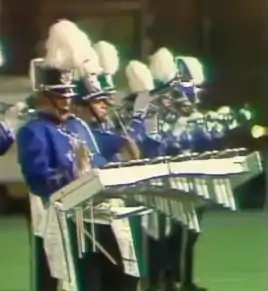Front ensemble
In a marching band, drum and bugle corps, or indoor percussion ensemble, the front ensemble or pit is the stationary percussion ensemble. This ensemble is typically placed in front of the football field, though some designers may use atypical layouts (such as having the front ensemble split into pods on the field). Some high school marching bands opt not to march any percussion instruments but instead have a "full" front ensemble.

Originally, the front ensemble consisted of keyboard percussion and timpani, the marching versions of which are heavy and awkward. Groups began adding more and more traditional percussion instruments to the pit, and in its modern form, the ensemble may contain any type of percussion instrument.[1]
The main emphasis of the front ensemble are the mallet instruments: marimba, vibraphone, glockenspiel, chimes, crotales, and xylophone. Some marching band circuits also allow non-standard instruments (such as the violin) or electronic instruments (such as synthesizers and bass guitars) in the pit.
The term "pit" comes from musical theater, where the accompanying orchestra sits in the orchestra pit.
History

The front ensemble was developed by member corps of Drum Corps International before being adopted by other marching ensembles.[2] Under the original rules Drum Corps International used with its founding in 1972, all instruments had to be marched without exception. Originally, timpani were the only pitched percussion instruments allowed to be marched. Later, keyboard percussion instruments were allowed to be marched: glockenspiels and xylophones were permitted in 1974, and marimbas and vibraphones were permitted in 1977.
Over time, people began to realize the physical strain of carrying these large, awkward instruments, and they were allowed to be placed on the ground in 1978. This allowed for the use of extended techniques (such as Stevens grip) and higher quality instruments (such as pedal timpani and extended range marimbas). The last year marching pitched percussion instruments were commonly used in competition was 1982.[3]
The use of electronic instruments in marching band is controversial and divisive within the marching band community and was prohibited outright by Drum Corps International until 2008 when it was passed in an 11–4 vote.[4]
Instrumentation
Instrumentation for the front ensemble is not completely standardized, and not all ensembles have access to certain instruments; high schools may not have even one of each mallet instrument. The three main sections of the front ensemble are the woods (e.g., marimba and xylophone), the metals (e.g., vibraphone, glockenspiel, crotales, and tubular bells), and the "rack-tronics" (e.g., the electronics, timpani, and non-pitched percussion).[5]

A typical front ensemble is made up of about 13–18 players:[6]
Electronic Instruments
1–2 synthesizers/samplers
References
Notes
- Rack players are responsible for the auxiliary percussion within the ensemble. The unique name derives from the specialized frame that such instruments are mounted on.
Sources
- Casella, Jim; Ancona, Jim (2003). Up Front : A Complete Resource for Today's Pit Ensemble. Tapspace. pp. 10–22. ISBN 978-0-9764344-2-9. OCLC 61265698.
- Morrison, Robert (July 1985). "The Development of the Front Percussion Ensemble" (PDF). Percussive Notes. 23 (5): 32.
- Summerlin, Lane (2016). The History and Development of the Front Ensemble in Drum Corps International (DMA dissertation). Ohio State University. pp. 15–51. OCLC 968152092.
- Maher, Erin (2011). The Amplification Controversy in Drum Corps International: Technological Change and the Meaning of Tradition (MA thesis). The University of North Carolina at Chapel Hill. p. 20. doi:10.17615/7jge-9e28.
- Giachetti, Jason J. (2022). A Qualitative Analysis of Front Ensemble Arrangements for Drum Corps International Finalists and Applications to Marching Band Programs (DMA dissertation). Five Towns College. pp. 40–75. ProQuest 2714144718.
- Dunbar, Leah Meredith (2020). Musical Identity and Arranging Styles of Drum Corps Front Ensembles (PDF) (BA thesis). Kenyon College. p. 5 – via Percussive Arts Society.